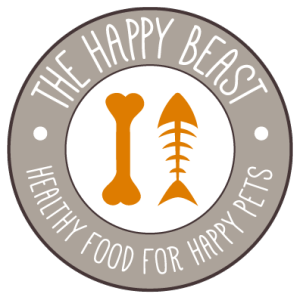Understanding Puppy Food
What’s different about puppy foods?
Dog food for puppies, or any food labeled for “growth and gestation” are required by the FDA to have higher levels of protein and fat than foods labeled for adult dogs. More specifically, puppy food must have a dry matter minimum of 22.5% protein and 8.5% fat, compared to minimum 18% protein and 5.5% fat for adult dogs.
Many dog food brands will cut the amount of protein and fat in their adult formulas because nutritionally-dense ingredients are expensive. These companies can use less expensive ingredients and still meet the FDA requirements. However, just because dogs can survive with these nutrient levels doesn’t mean they will thrive.
Instead of taking this approach, at The Happy Beast, we recommend quality brands and foods for puppies that are labeled for ‘All Life Stages,’ meaning the diet is appropriate for dogs from puppyhood all the way through their senior years. Instead of replacing high quality meat with less expensive fillers for adult dogs, the brands we recommend choose to promote a high protein diet in line with the nutritional requirements of a canine for the entire life of the dog.
Special Consideration for Large Breed Puppies
The term ‘large breed’ is generally used for dogs that are at least 70 lbs when they are full grown. Conservatively, we can lump puppies who will be 50 lbs or more into this group when we look at feeding requirements. The most up-to-date research tells us that we need to control calorie and calcium intake to make sure these puppies don’t grow too quickly. While many hip and joint problems are caused by genetics, slow and consistent bone growth throughout puppyhood is thought to reduce the severity of conditions like hip and elbow dysplasia, osteochondrosis, and developmental orthopedic disease.
If you have a large breed puppy, carefully regulate how many calories are consumed on a daily basis, including bones, chews, and treats. Check your puppy’s weight frequently. You should be able to feel his ribs without using too much pressure when you run your hands over his sides.
Fresher is always better!
Incorporate as much fresh food into your puppy’s diet as possible, which will naturally include a variety of beneficial nutrients and enzymes, which help promote digestion. There are a variety of fresh food options, but a few of our favorites include:
- Treats: Air-dried or freeze-dried like The Real Meat Co, Smallbatch, and ZiwiPeak
- Raw Goat Milk: Bark n’ Big, Pure, or Answers
- Meal Toppers: Rehydrated Sojo’s or Grandma Lucy’s
In summary, puppyhood is a critical time for your dog to develop a healthy digestive system, which helps build and strengthen your dog’s overall immune system. While there can be a lot of hype around “puppy food” labels, we recommend you simply choose a balanced, raw food (frozen, air-dried, or dehydrated) as a simple way to ensure you’re giving your puppy everything he needs to live a long, healthy, and happy life.
Got a new puppy at your house? Stop by the store to talk more and we’ll help you figure out the best option for your pup.






